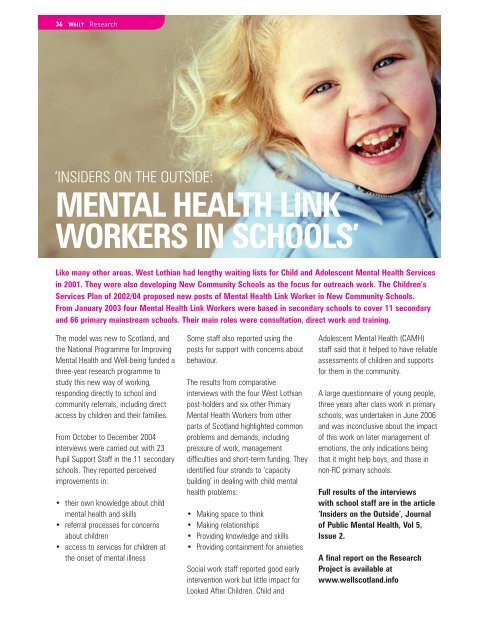Well? Issue 10: Spring/Summer 2007
Well? Issue 10: Spring/Summer 2007
Well? Issue 10: Spring/Summer 2007
Create successful ePaper yourself
Turn your PDF publications into a flip-book with our unique Google optimized e-Paper software.
36 <strong>Well</strong>? Research<br />
‘INSIDERS ON THE OUTSIDE:<br />
MENTAL HEALTH LINK<br />
WORKERS IN SCHOOLS’<br />
Like many other areas, West Lothian had lengthy waiting lists for Child and Adolescent Mental Health Services<br />
in 2001. They were also developing New Community Schools as the focus for outreach work. The Children’s<br />
Services Plan of 2002/04 proposed new posts of Mental Health Link Worker in New Community Schools.<br />
From January 2003 four Mental Health Link Workers were based in secondary schools to cover 11 secondary<br />
and 66 primary mainstream schools. Their main roles were consultation, direct work and training.<br />
The model was new to Scotland, and<br />
the National Programme for Improving<br />
Mental Health and <strong>Well</strong>-being funded a<br />
three-year research programme to<br />
study this new way of working,<br />
responding directly to school and<br />
community referrals, including direct<br />
access by children and their families.<br />
From October to December 2004<br />
interviews were carried out with 23<br />
Pupil Support Staff in the 11 secondary<br />
schools. They reported perceived<br />
improvements in:<br />
• their own knowledge about child<br />
mental health and skills<br />
• referral processes for concerns<br />
about children<br />
• access to services for children at<br />
the onset of mental illness<br />
Some staff also reported using the<br />
posts for support with concerns about<br />
behaviour.<br />
The results from comparative<br />
interviews with the four West Lothian<br />
post-holders and six other Primary<br />
Mental Health Workers from other<br />
parts of Scotland highlighted common<br />
problems and demands, including<br />
pressure of work, management<br />
difficulties and short-term funding. They<br />
identified four strands to ‘capacity<br />
building’ in dealing with child mental<br />
health problems:<br />
• Making space to think<br />
• Making relationships<br />
• Providing knowledge and skills<br />
• Providing containment for anxieties<br />
Social work staff reported good early<br />
intervention work but little impact for<br />
Looked After Children. Child and<br />
Adolescent Mental Health (CAMH)<br />
staff said that it helped to have reliable<br />
assessments of children and supports<br />
for them in the community.<br />
A large questionnaire of young people,<br />
three years after class work in primary<br />
schools, was undertaken in June 2006<br />
and was inconclusive about the impact<br />
of this work on later management of<br />
emotions, the only indications being<br />
that it might help boys, and those in<br />
non-RC primary schools.<br />
Full results of the interviews<br />
with school staff are in the article<br />
‘Insiders on the Outside’, Journal<br />
of Public Mental Health, Vol 5,<br />
<strong>Issue</strong> 2.<br />
A final report on the Research<br />
Project is available at<br />
www.wellscotland.info

















